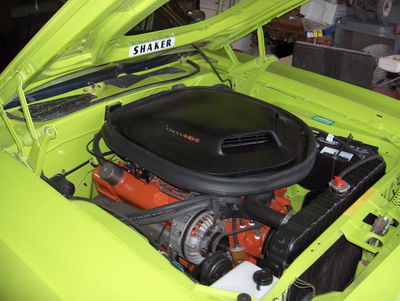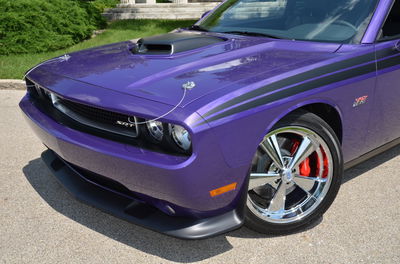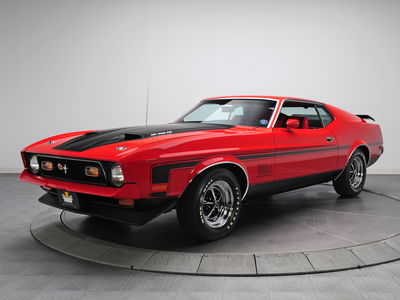What Is A Shaker Hood, And How Do They Work?

The hoods or bonnets of cars can take all shapes and sizes, with designs ranging from purely artistic curves to very much functional divots and scoops. In performance-orientated cars, airflow is usually the main factor when deciding upon a bonnet design due to the need for efficient cooling and large volumes of induction air to feed whatever behemoth of an engine is nestled under the hood.
Massive air scoops are therefore extremely common in the performance car sector, used to catch the fast moving air passing over the bonnet and force it in through the intake and air filter to the intake manifold. But there’s a specific form of integral air scoop that has been used on multiple legendary muscle cars that pushes the average bonnet scoop up a few notches of functionality.
It’s called a shaker hood (or shaker scoop) and instead of being part of the car’s bonnet, it is instead an air intake attached directly on top of the air filter (or air cleaner), which in many American muscle cars is positioned on top of the engine block. The name comes from the fact that the air intake shakes as the engine turns over, with the vibrations created from the reciprocal movements transmitting upwards and forcing the intake to tremor.
A shaker hood effectively works as a short ram intake which has a couple of benefits over a standard air intake system. Firstly, the distance the air has to travel before entering the engine’s cylinders is massively reduced due to the lack of long piping that is needed for a general air box system. This means that the intake air experiences much less air resistance as it enters the intake system, thus decreasing unwanted friction and allowing the air to pass smoothly and quickly into the intake with greater efficiency.
The second benefit is the fact that the larger volume of air capable of entering the engine repeatedly makes for an increase in power. As we all know, you need three basic things for combustion; oxygen, fuel and a spark. By maximising the influx of oxygen to the cylinders, the energy from each combustion cycle will be increased, thus making for a suitable gain in power.
The air will also not have a chance to heat up due to the shortened distance that is has to travel within the engine bay. This cool air is suddenly condensed as it enters the air intake constriction, further increasing the efficiency of the resultant internal combustion due to the large temperature difference between the intake air and the ignition spark.

Debuting in the Plymouth Barracuda and Dodge Challenger, the shaker hood quickly became synonymous with the legendary American muscle cars powered by the HEMI V8. The big-block engines produced a huge amount of vibration emanating up from the rudimentary OHV systems of the day, forcing the intake to hop and jump around the gaping hole cut in the bonnet to house the component. Chrysler therefore coined it as the “Incredible Quivering Exposed Cold Air Grabber”, but the petrolheads of the time quickly changed the long-winded trademark for the much cooler slang that lives on to this day.
Unfortunately, air intakes like this rely on the speed of the air entering the scoop to define their efficiency. And even then, the sheer amount of air that an internal combustion engine has to suck into itself for combustion means that the intake air never really gets the chance to reach any high levels of pressure before being forced through the intake manifold. So although they look cool and theoretically have a genuine function, power gains are minimal from such intakes and therefore they shouldn’t be seen as the holy grail of horsepower.

The HEMI V8 went through a bit of a slump in sales as fuel prices went through the roof in the 1970s and 1980s and as a consequence shaker hoods became less common, but Dodge decided to bring back that little taste of retro ‘Murica with its Challenger SRT10 concept back in 2008. Despite the main furore based around the Viper V10 under the bonnet, many keen-eyed fans spotted what seemed to be a shaker hood intake protruding from the depths of the engine bay.
Dodge then stayed true to its conceptual promise by introducing a shaker kit on the 2014 Challenger to sit atop the V8 powerplant once again. The massive popularity of the retro intake forced Dodge to then feature the shaker hood on its 2015 Challenger as well, with the package being available on all R/T, R/T Plus and 392 Scat Pack trims.

Other famous cars that featured such an intake include the Ford Torino, Ford Mustang Mach 1 special edition and the Pontiac Firebird and GTO, so it’s easy to see why Americans of a certain age get all wide-eyed over the shaker hood legend.
Although it may not have been revolutionary, the shaker hood definitely has its place in the progress in muscle car engineering back in the 1970s and despite power gains being minimal to say the least, the presence of an engine trying to seemingly rip itself free from its own mounts is a sight to behold.













Comments
My Shaker-scoop brings all the boys to the yard and there like “It’s better than your scoop”
That was atrocious…
On the purple Challenger, what are those silver cables attached to the bonnet are for?
on a normal car you have hinges but to save weight, some cars have wires instead.
Just a hood latch. Instead of a complex, heavy locking hood-release mechanism, just add pins and cables
They theoretically keep the bonnet from flying up too far if the bonnet latch were to suddenly fail, though they’re mostly for show when fitted from the factory, it’s another nod to the early 70s
That video is better than porn.
“Incredible Quivering Exposed Cold Air Grabber”
it just reminds me of the trash cans we have in norway.
I always think of BMW when I see those…
On subaru’s and many other vehicles the hood scoop is not an air intake. Seeing the image of the sti in there Id wanted to add that scoops sometimes are added to cool the engine bay or direct air through a cooler of some kind, typically a top mounted intercooler which is a common sight on turbo subaru’s. :)
Yes, not sure about the new one but on older models the scoop is funneled onto the intercooler then channeled out through the transmission tunnel providing cooling for the transmission.
Although shaking at idle is cool, nothing is better than seeing it hold itself to the right when under full throttle. By the way, the XY GT Falcon also has one
Advantages: looks dope af
Disdvantages: who cares?
426 Hemi was a big block Chrysler not a small block
I was thinking the same thing, but I wasn’t sure.
During the time of the 2nd gen hemi, Chrysler small blocks (that were known for performance) were: 318, 340, 360, 400. Big blocks were 383, (400), 426, 440
The 360 didn’t come into its own as a performance engine until quite some time later. When it was released, it was sold strictly as a low compression engine designed to meet emissions standards.
Pagination